Cactaceae (cactus family)
by Mark A. Dimmitt
The enormous popularity of cacti among gardeners and plant collectors is surpassed only by that of roses and orchids. Their appeal extends far beyond their native habitat; there are legions of devotees in the eastern United States, Europe, and Japan. The desire to possess these strange yet beautiful plants supports hundreds of specialty nurseries; the largest shops grow and sell millions of plants annually. Cacti are one of the reasons tourists visit the American southwest.
Description of Family
Most people think they know a cactus when they see one, but they are often mistaken. All cacti are succulents, but not all succulents are cacti. Agaves, ocotillos, aloes, and the succulent euphorbias (such as African milk trees) are among the swollen or spiny plants often mistaken for cacti. However, the term cactus refers to a particular family of plants defined by a distinctive flower pattern. To be a cactus, the plant must produce flowers with the following characteristics: many tepals (combined sepals and petals) that intergrade with each other; many stamens (usually hundreds), and numerous stigma lobes (rarely only three). If a plant lacks such a flower, it cannot be a cactus.
Range
The cactus family is nearly endemic to the New World from southern Canada to southern South America. There is an exception — one of the 1800 species occurs naturally in Africa, Sri Lanka, and Madagascar. However, introduced cacti have gone wild and sometimes become pests in several regions of the Old World. Cacti are most common (in numbers of both plants and species) in semiarid habitats with low rainfall, yet with dependable rainy seasons. A few species occur in extremely arid deserts and wet tropical forests. About 300 species occur in the Sonoran Desert region.
Notes
The majority of cactus species are pollinated by numerous species of bees, a number of which specialize in cacti. Cactus bees are all solitary, but in some species the females congregate by hundreds of thousands at nesting sites to dig their individual nest burrows, which are densely concentrated in an area of a few thousand square feet. Cactus pollen is packed into these burrows to feed the grubs, which the parents do not tend. Some cacti are pollinated by birds, moths, or bats.
Giant Columnar Cacti:
Saguaro, Organpipe, Senita, and Cardon
Two defining life forms of the Sonoran Desert’s vegetation are giant columnar cacti and legume trees. Both are characteristic of arid tropical habitats (the cacti only in the “New World”) and their presence in the Sonoran Desert reflects its affinity to the tropics. Arizona Upland (a sub-divison of the Sonoran Desert) experiences frequent frosts, and only one columnar cactus (the saguaro) is sufficiently cold-hardy to be widespread in this subdivision. The Lower Colorado River Valley subdivision is too dry for columnar cacti and they are almost absent there. Several species of giant columnar cacti occur in each of the other four subdivisions.
In addition to the giants described below, there are several smaller columnar species in the Sonoran Desert, and even more small and large species in the adjacent tropical communities. Myrtillocactus cochal (cochal) occurs in Baja California. It branches profusely from a short trunk, forming a large candelabra-shaped mass of stems up to 13 feet (4 m) tall and wide. Repeat photography indicates that it lives only a few decades. Bergerocactus emoryi (golden torch cactus), also from Baja California, has very slender stems to about 7 feet (2 m) tall densely clothed with yellow spines. Pachycereus pecten-aboriginum (etcho, hecho, cardón barbón) resembles a skinny cardón. Its fruit is very bristly and used as a hair brush. It is mainly a thornscrub species that enters the southern edge of the Sonoran Desert in southern Sonora and southern Baja California.
Carnegiea gigantea
English names: saguaro, giant cactus
Spanish names: saguaro
The huge green columns of saguaros have captivated the attention of nearly every tourist who has set eyes on one, let alone a whole “forest” of them. The United States has even devoted a national park to this plant. Saguaros are even more important to the O'odham peoples who have lived in their habitat for centuries. The high esteem O'odham have for saguaros is reflected in their many creation stories for this plant, which tend to share the common theme of people being turned into saguaros. These giant cacti are not plants to the Tohono O'odham; they’re another form of humanity.
The saguaro is the most thoroughly studied plant in the Sonoran Desert. Therefore its ecology can be described in considerable detail. Nearly every other organism in its range (including humans) can be ecologically connected to it in some way.
Description
The saguaro is the largest cactus in the United States, commonly reaching 40 feet (12 m) tall; a few have attained 60 feet (18 m) and one was measured at 78 feet (23.8 m). The cylindrical stems are accordion-pleated; the ridges (outer “ribs”) are lined with clusters of hard spines along the lower 8 feet (2.4 m) and flexible bristles above this height. White flowers are about 3 inches (8 cm) in diameter; they bloom mainly in May and June and are followed a month later by juicy red fruit.
Range
The saguaro’s range is almost completely restricted to southern Arizona and western Sonora. A few plants grow just across the political borders in California and Sinaloa. Saguaros reach their greatest abundance in Arizona Upland. Plants grow from sea level to about 4000 feet (1200 m). In the northern part of their range they are most numerous on warmer south-facing slopes.
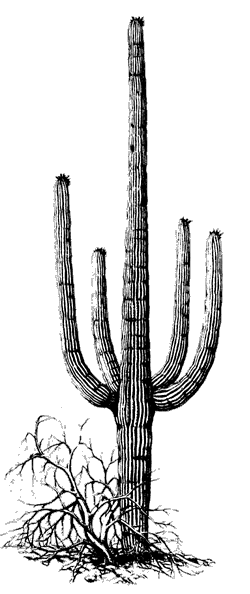
Anatomy
This anatomical description of the saguaro is generally applicable to other cacti as well, except that most smaller species have less well-developed woody skeletons. The epidermis (“skin”) is covered with a thick, waxy cuticle that waterproofs the surface and restricts transpiration (loss of water vapor) almost exclusively to the stomates (pores for gas exchange). The outer surface is folded into pleats (commonly called “ribs”, but not to be confused with the internal, woody ribs). These pleats enable the stem to expand in girth during water uptake without stretching and bursting. Areoles, the roundish pads from which the spines and usually the flowers are produced, are distributed at 1-inch (2.5 cm) intervals along the ridges of the ribs. Each areole bears a cluster of about 30 spines, the longest up to 2 inches (5 cm) long. The spines are stout and sharp on young plants. Stems taller than about 8 feet (2.4 m) produce bristly spines. Spines serve multiple functions, primarily protection from herbivorous animals and from sun; their shade reduces heat load and consequent water loss. The lower trunks of old saguaros lose their spines and develop dark, corky bark.
Immediately beneath the epidermis is a thin layer of chlorophyll-containing cells where most photosynthesis takes place. The deeper interior — most of the bulk of the plant — consists of water storage tissue (parenchyma). Water comprises most of the weight of the saguaro. A fully hydrated large stem is more than 90 percent water and weighs 80 pounds per foot (120 kg per meter).
The great, mostly aqueous bulk of larger plants protects them from temperature extremes. Heat absorbed through the surface during the day is stored in the mass of interior tissue, resulting in a fairly small temperature rise that doesn’t reach a lethal level. The heat is slowly radiated and conducted back into the air during the cooler night. The same thermal inertia usually keeps the tissues above freezing on cold winter nights.
Near the center of the stem is a cylinder of 13 to 20 woody ribs running the length of the main stem and branching into the arms. In the upper part of a stem the ribs are separate; as the stem ages the ribs continue to grow and fuse into a latticed cylinder.
A tap root extends downward to more than 2 feet (60 cm). The rest of the extensive root system is shallow, as is the case for most succulents. Roots are rarely more than 4 inches (10 cm) deep and radiate horizontally about as far from the plant as the plant is tall.
Occasionally abnormal growths occur, the best-known type called a “crest”. This fan-topped form results when the apical meristem (the actively proliferating tissue at the growing tip) broadens from its normal point into a line of dividing cells. The cause in saguaros and other cacti is not known, other than that it usually seems to follow damage to the growing point. It does not harm the plant, which frequently continues to produce flowers and fruit. Crests are occasionally found in nearly all plant species; the phenomenon is especially noticeable in saguaros because of their size. (The garden cockscomb, found in many nurseries, is a genetically stable crested mutant of the Chinese woolflower, Celosia argentea.) Other saguaro anomalies occasionally encountered are ribs that undulate or spiral.
Reproductive Ecology — Flowering to Germination
Saguaros flower mostly near the stem tips during the dry foresummer; peak production is from mid-May to mid-June. The sturdy white flowers open late at night and remain open until midafternoon of the next day. They are about 3 inches (8 cm) in diameter and emit an aroma like that of overripe melon. The flowers are self-sterile; cross-pollination is necessary for fruit set.
Characteristics of the flowers point almost unambiguously to pollination by bats. The nocturnal opening of buds, maturation of pollen, and production of nectar; their exposed position high above the ground, their heavy texture, the particular fragrance emitted at night, and the copious nectar and pollen, are all characteristic of bat flowers. Even the proportions of amino acids in the pollen protein matches that of bats’ nutritional needs more closely than that of other animals. The only anomalies are that the flowers remain open well into the next day and produce more nectar after sunrise. For years the bat-saguaro mutualism (mutually beneficial relationship) went unquestioned, until a field biologist examined the relationship closely. Reality turns out to be more complicated, as is usual in nature.
Many bats feed on nectar and fruit rather than on insects. Two species, the lesser long-nosed bat (Leptonycteris curasoae) and the Mexican long-tongued bat (Choeronycteris mexicana), occur in saguaro habitat. After wintering in tropical Mexico, the lesser long-nosed bats migrate up the arid coast of Sinaloa and Sonora beginning in March, feeding mostly on columnar cactus flowers. The flowers supply their complete diet during migration. The nectar provides energy-rich carbohydrate for flight. The pollen that clings to their furry faces while they’re lapping up nectar is swallowed as the bats groom themselves at roost. Pollen provides most of their dietary protein. Their feeding activity also effectively pollinates flowers.
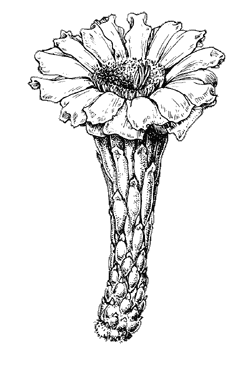
Saguaro flower
Near Kino Bay, Sonora, where there is a major Leptonycteris bat roost, Ted Fleming and associates caged different saguaro flowers against animal visitors during either daytime or nighttime. To their surprise, the flowers that were exposed during the day had a much higher rate of pollination (resulting in fruit set) than did those exposed at night. During the day, flowers were visited by great numbers of bees (mostly introduced honeybees) and birds (mostly white-winged doves). At night the bats were present, but spent most of their time feeding on cardón and organpipe cacti, which were also common at the site.
One cool spring when the bats arrived from the south before the cardón and organpipe cacti began to flower, they fed heavily on saguaros. But in most years bats seem to be minor players in saguaro pollination. The saguaro story is similar farther north. The range of cardón stops south of the U.S.-Mexico border, and organpipes barely extend into southern Arizona. Saguaros occur well north of Phoenix in eastern Arizona and almost as far north as Kingman in western Arizona, but the bats rarely venture north of Tucson. While bats depend heavily on saguaros at the northern limit of their summer migration in southern Arizona, they are apparently too few in number to be important saguaro pollinators there. The many saguaro populations north of the bats’ range must depend entirely on other pollinators. Among them is the native bee Diadasia opuntiae, which despite its name prefers saguaros over prickly pears or chollas.
As is often the case in scientific research, the Fleming study raises more questions than it answers. If bees and doves accomplish most of the pollination, why do saguaro flowers still have mostly bat-attracting characteristics? Have we encountered the early stage of an evolutionary shift? In 100,000 years will saguaros have diurnal yellow flowers? Or do the bats still have sufficient, yet-unknown influence on saguaro evolution to maintain the status quo?
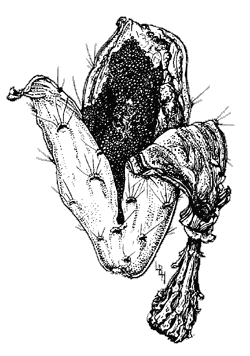
Saguaro fruit
In June and early July the pollinated flowers mature into 3-inch (8 cm) long fruits containing up to 2000 tiny seeds embedded in juicy, red pulp. The rind splits into 3 or 4 sections and peels back to expose the pulp and a red inner lining. These open fruits are often mistaken for red flowers.
The fruit ripens in tremendous abundance during the peak of the foresummer drought, and is nearly the only moist food available during this hottest, driest time of the year. It becomes a staple for many birds, mammals, and insects during late June and early July. The primary effective seed dispersers are several species of fruit-eating birds, such as White-winged Doves, Gila Woodpeckers, and House finches. The birds digest the pulp, and the seeds pass through their guts intact. Birds also tend to defecate while perched in trees, thus depositing the seeds in favorable environments for establishment. Long-nosed bats also consume cactus fruits, but they defecate while flying or roosting in caves, so most seeds land where they can’t grow. (See the story of the bats’ southward migration in the section on Agavaceae.)
Fruit ripening occurs just before the summer rainy season arrives in the eastern Sonoran Desert. Seeds germinate in about 5 days after a rain. The rest of the plants’ life cycle is spent at a much slower pace.
Growth from Seedling to Maturity
Seedlings grow very slowly during their first few years and are extremely vulner-able. They are tiny, heat- and frost-tender, soft-spined canteens. Rodents, rabbits, and birds eat the seedlings they can find, and many others succumb to desiccation or winter freezes. Nearly all survivors are located beneath the canopies of nurse plants, where they are sheltered from weather extremes and concealed from herbivores. Most desert plant species — not only saguaros — must begin life under nurse plants. Creosote bush, bursage, and desert zinnia are among the few perennials that can successfully establish in fully exposed sites.
Even in the shelter of nurse plants, most saguaro seedlings perish from drought, frost, or predation. Significant establishment of seedlings requires several consecutive years of milder and wetter-than-average weather. Such conditions occur only a few times a century in Arizona Upland, and even less frequently in the Lower Colorado River Valley community. This results in saguaro populations with only a few size and age classes. For example, 60 years after a favorable establishment period, there will be a large group (called a cohort) of recently-matured plants averaging 10 feet (3 m) tall. The same area may have only 2 or 3 other size-age cohorts; one several decades younger, another several decades older, with few plants in between. Southern Arizona experienced wet summers and mild winters during the first half of the 1980s. The cohort of seedlings that probably established during this period will begin protruding above their palo verdes (Cercidium spp., the most common saguaro nurse plants in Arizona Upland) at about year 2030.
Growth rate is controlled mainly by the amount of rainfall, plant size, and soil type. A tiny seedling has very little water-storage tissue and a relatively large surface area through which water is lost. Soon after a rain it exhausts its meager supply, stops growing, and goes into cam idling mode. (See the discussion of cam in the chapter “Plant Ecology of the Sonoran Desert Region.”) Larger plants contain more water relative to the enclosing surface area, and can continue to grow for several weeks after rain. Therefore saguaro growth rates increase as the plants get larger.
In the Tucson Mountains, which averages 14 inches (355 mm) annual rainfall, a saguaro takes about 10 years to attain 1¼ inches (3.8 cm) in height and 30 years to reach 2 feet (61 cm). Saguaros begin to flower at about 8 feet tall (2.4 m), which takes an average of 55 years. Compare this with 40 years to first flowering in the wetter eastern unit of Saguaro National Park (16 inches, 406 mm, average annual rainfall) and 75 years in the drier Organ Pipe Cactus National Monument (9 inches, 230 mm). No one has studied the populations near Yuma, which receive about 3¼ inches (90 mm) average annual rainfall.
Saguaros may begin to grow arms when the plant is between 50 and 100 years of age (in the Tucson Mountains), usually just above the stem’s maximum girth at about 7 to 9 feet (2.1 to 2.7 m) above-ground. The number of arms and overall size of a plant seem to be correlated with soil and rainfall. Saguaros on bajadas with finer, more water-retentive soils tend to grow larger and produce more arms than do those on steep, rocky slopes. A few saguaros have been observed with as many as 50 arms; many never grow arms. Saguaro arms always grow upwards. The drooping arms seen on many old saguaros is a result of wilting after frost damage. The growing tips will turn upwards in time. There is a myth that arms are produced so as to balance the plants, but research shows arm-sprouting to be random. Many saguaros can be found with several arms all on the same side of the main stem.
Ecology of Mature Saguaros
Old saguaros often stand alone on open ground. They not only outlive their nurse plants, they may hasten their deaths. Since a saguaro’s root system is shallower than that of palo verdes or other nonsucculents, in dry years the saguaro intercepts most of the meager rainfall. Trees and shrubs within the root zone of a saguaro are thus more likely to succumb to drought than those that lack such competition.
Animal associations with saguaros are many and varied. Numerous species of vertebrates and invertebrates use this plant for food, shelter, and perching sites. Some of these associations are described throughout this book.
Saguaros make excellent nesting places for many birds. The primary nesting associates are Gila woodpeckers and gilded flickers, both of which excavate nest holes in the fleshy stems. The plant seals the wound with scar tissue called callus, which quickly becomes very hard and impervious to microbial infection. Callus tissue decomposes more slowly than most of the rest of the saguaro and can be found on the ground among the debris of dead plants. Because of their shapes the callus remains of nesting holes are called “saguaro boots”. The Seri used both saguaro and cardón cactus boots to carry and store food.
Gila woodpeckers typically excavate nest holes in the thick, older sections of stems between the epidermis and the cylinder of woody ribs. These holes seem to cause no serious damage to the saguaro unless they‘re very numerous. In contrast, flickers usually excavate larger holes higher on the stem and penetrate the interior rib cylinder. This interrupts water and nutrient transport, and the stem’s further growth is greatly impeded. Stems weakened by flicker holes are also more easily broken by storm winds. Broken stems may themselves branch to produce one to several arms; this increases the potential seed production of the plant. But research also suggests that flicker holes may do sufficient damage to cause death of the plant.
Woodpeckers usually excavate new nesting holes each year. Several other hole-nesting but non-excavating birds occupy abandoned woodpecker nests, including elf owls, house finches, ash-throated flycatchers, and purple martins. Invertebrates also inhabit them.
Larger birds such as red-tailed hawks build nests in the angles between the main stems and the arms. Tall saguaros also make good hunting and resting perches for many birds. Cactus wrens sometimes nest among the arms or, less often, in a woodpecker cavity.
Mortality
Saguaros die from different causes at different sizes. The vast majority of seedlings die in the first year from drought or frost. Some birds, such as curve-billed thrashers, dig them up in search of insects. Larger seedlings up to about a foot (30 cm) tall, or 2 decades of age, suffer high mortality from being eaten by rodents and rabbits. The few that survive to about 3 feet (1 m) tall at about 40 years of age are much more resistent to weather extremes and animal damage, and mortality is low from then into old age.
Some mature saguaros are killed by lightning strikes, windthrow, and perhaps from flicker damage. The chief agent of mortality of mature saguaros in the Arizona Upland is freezing temperatures. The saguaro is a tropical cactus with limited frost tolerance, and it reaches the northern, coldest limit of its range in Arizona Upland. Small to medium-sized plants are protected by the canopy of their nurse plants. Larger plants in the open are protected by their thermal mass and small surface to volume ratio (that is, a great volume for storing heat and relatively small surface area for losing it). But saguaro stems begin growing thinner above about 12 feet (3.7 m), while continuing to add outer ribs (pleats). This increases the surface to volume ratio and makes older plants more vulnerable to freezing.
It is difficult to determine the lethal temperature for a saguaro or other plant. The seasonal timing and duration of freezing temperatures are at least as important as the minimum temperature. Healthy middle-aged saguaros have survived 10°F (-12°C) for a few hours in mid-winter, while 12 hours of 20°F (-7°C) in late fall have caused widespread damage and death.
Several times each century strong winter storms push arctic air masses deep into the Sonoran Desert. These hard freezes damage or kill the smallest and largest saguaros, as well as other tropical elements of the flora. Most often these freezes kill a portion of the outer layer of saguaro tissue, which forms a brown scab tissue. Since saguaros have a relatively small photosynthetic area to begin with, a significant reduction of this area results in slow starvation. A frost-damaged saguaro may survive for another decade or even longer, but eventually it weakens until it can no longer resist infection. Bacterial rot caused by Erwinia cacticida turns the flesh of weakened plants into an odoriferous black liquid. Erwinia is at most a weak pathogen; healthy cacti normally wall off small infections and continue to thrive. Several species of fruit flies and other insects are specialized to feed on rotting saguaro tissue.
The Erwinia bacterium is common in the environment. One vector (an agent of transmission) is the blue cactus borer, the larva of the moth Cactobrosis fernaldialis. The maggot-like caterpillar burrows into the flesh of saguaros and other cacti, feeding on the bacterial rot it introduces. Living saguaros typically have many round, ¼-inch (1.3 cm) scabs on their surfaces. Sifting through a rotted carcass will reveal that these scabs are the outer ends of contorted cylinders of callus tissue; they are the healed tunnels left behind by cactus borers. There are other shapes and sizes of calluses in between these “worm holes” and woodpecker boots; their causes remain a mystery.
Fallen saguaros become homes for many small animals. Snakes, rodents, lizards, and invertebrates find shelter beneath and within them, until the community of reducers and decomposers completely recycle the remains.
A Modern Myth: The Impending Doom of the Giant Cactus
The imminent demise of the saguaros is a recurring rumor dating back several decades. Its most recent incarnation began in the early 1990s and refuses to die, despite having been soundly refuted. It is an interesting story involving flawed science compounded by bad journalism. Briefly, here is what happened:
Visiting biologists who had not previously worked in the Sonoran Desert noticed that many of the large saguaros had brown, scabby skin and were evidently in declining health. They published a paper labeling the problem “brown decline” and postulated several possible causes, including air pollution and ultraviolet radiation through the hole in the ozone layer.
The authors misinterpreted the situation they observed because they were not familiar with saguaro ecology. The misinterpretation might be analagous to a situation in which extra-terrestrials briefly visit earth and collect a sample of people from a nursing home. Their specimens would be mostly old and in poor health, and the aliens would have concluded that the human species was on the brink of extinction. Should they sample an elementary school they would reach a very different but equally wrong conclusion.
The large, conspicuous saguaros that dominate the Sonoran Desert landscape are analogous to the nursing home population. They were indeed old and many were declining. These comprised the few members of their age group that had barely survived the catastrophic freeze of December 1978. The scientists, however, failed to notice the large population of young, healthy saguaros in the “elementary schools” that were concealed under nurse trees.
The alarm sounded by this article would not have become widespread except for the unfortunate tendency of many journalists to seek sensational stories. The disappearance of our giant cacti was a major story, but their health and continued existence are barely newsworthy. The media picked up the scientific paper and published its gloomy speculation. Numerous local biologists were interviewed by journalists all over the world. All of the local biologists refuted the idea that saguaro populations were declining. Some media decided not to carry the story upon hearing the contrary evidence. But others published or broadcast dramatic stories forecasting impending doom for the giant saguaro, and only briefly mentioned, or omitted altogether, the contradictory opinions. This erroneous story recirculates when writers quote these past inaccurate publications.
Deeper History
The saguaro doom story first surfaced in the 1940s; at that time little was known about saguaro ecology. Saguaro National Monument was established in 1933 east of Tucson. That bottomland area was chosen because it had a tremendous population of giant old saguaros. (It had few young or middle-aged saguaros, due to the effects of livestock grazing and the cutting of potential nurse trees since the late 1800s.) But there was a catastrophic freeze in 1937, and during the next decade the giant forest was suffering massive mortality from bacterial necrosis. The Park Service bulldozed and buried thousands of rotting cacti in the hope of stopping what it mistook as a new, virulent disease. These efforts failed, and the alarm over the presumed fate of the saguaros became a factor in the establishment of the West unit of Saguaro National Monument on the other side of Tucson in 1961. This location in the Tucson Mountains did not have a cohort of giants so the impact of the freeze of 1937 was less evident, or according to the view of that time, the bacterial necrosis disease had not infected this population. (The western unit had mature stands of giants by the mid 1970s; this cohort was devastated by the freeze of 1978.) This first misinterpretation of the ecology of saguaros had a positive outcome — it engendered the preservation of another tract of splendid desert. Both units of the National Monument were designated Saguaro National Park in 1994.
So are saguaros declining? The answer is, yes, most of the time. So are most species of desert plants and animals — that’s the nature of this ecosystem. In most years there is slightly higher mortality than recruitment (the successful establishment of new individuals), so populations decrease. In years of severe droughts or freezes the mortality can be dramatic. In the occasional wet years mass recruitment reverses the trend of decline with a reproductive boom. In the case of saguaros these episodes of net recruitment seem to occur less than a half-dozen times per century in Saguaro National Park (west), and less often in the drier regions.
Hard data are available for establishment frequency of another plant on the western edge of the desert. Desert agaves (Agave deserti) successfully established seedlings in the foothills near Palm Springs, California only once in 17 years of study. Therefore this agave population was either maintaining the status quo or losing ground during 16 of those 17 years. Judging from the huge number of plants growing there, it’s obvious that they’re getting along just fine with these population dynamics.
Ethnobotany
Saguaros are good examples of the temporary, ever-changing nature of plant distributions. Its current geographic range is quite recent; saguaros have been expanding from their Ice Age refugia for the last 10,000 years. They arrived in the Tucson vicinity only 8000 years ago, according to the fossil record. Humans have been living in southern Arizona longer than have saguaros. (See “Deep History of the Sonoran Desert” chapter.)
The saguaro is a focal point in the culture of the Tohono O'odham Indians. Some O'odham calendar months are named for seasonal changes of the saguaro. The woody ribs are used for fence-making and combined with ocotillo, grasses and mud in building dome-shaped houses. Saguaro fruit is an important seasonal food, available immediately after the season called the “Painful Moon” or “Hunger Hurting Moon”. There is a scarcity of natural food during the foresummer drought preceding the saguaro fruit ripening. The beginning of the Tohono O'odham year is the “Saguaro Harvest Moon”. In June and early July, O'odham live in temporary camps in the saguaro forests and conduct the saguaro fruit harvest (hasañ bahidaj). Women use poles made from saguaro ribs to knock off the saguaro fruit. The pulp is boiled down into syrup. Some of the syrup is used to make a wine that is consumed during the rainmaking ceremony. The seeds are dried and used in the winter as a snack, or ground into flour and made into a gruel. Saguaro fruit is nutritious, containing 10 percent protein and 70 percent carbohydrates; the seeds are 30 percent fat.
Cultivation
Saguaros are popular for landscaping. Large plants are collected from the wild, which is legal with permits from the state of Arizona and the landowner. However, the success rate of transplanting large saguaros is disappointing and the practice should be discouraged. The five-year survival rate of saguaros over 15 feet (4.6 m) tall is less than 10 percent, despite the best care the Desert Museum can provide. The 5-year criterion is necessary because a mortally damaged saguaro can take several years to die. (The plants occasionally survive for a decade or more in an emaciated state, continuing to flower yearly. A transplant is not counted successful unless the cactus regains its former girth and resumes normal growth.) Observations of large landscaping and salvage jobs throughout southern Arizona indicate that similarly low success rates are the norm.
Saguaros up to 10 to 12 feet (3-3.7 m) tall nearly always transplant successfully if they are treated properly. At least a foot (30 cm) of the 2 to 4 major lateral roots must be excavated without damage. The plant must be replanted no deeper than it was growing originally; covering any of the trunk with soil is frequently fatal just as it is to almost all trees. The hole must be filled with soil with excellent drainage. If the cactus is not positioned as it was originally oriented, then shade must be provided to prevent sunburn on its side to the sunny south. Lastly, the plant needs occasional irrigation for the first year.
Saguaros are not necessarily slow growers in cultivation. Nursery-grown seedlings 1 to 2 feet (30-60 cm) tall are widely available. If planted in a suitable climate and watered and fed regularly, these cacti can reach flowering size in as little as 15 years. Saguaros are some of the few cacti that do not root readily from cuttings. Though cuttings do occasionally root, they do not regain their juvenile growth form (tapered trunk with stout spines), and so always look like saguaro arms stuck in the ground.
Stenocereus thurberi
English name: organpipe cactus
Spanish names: mehuelé, pitahaya dulce (sweet pitahaya), órgano, marismeña
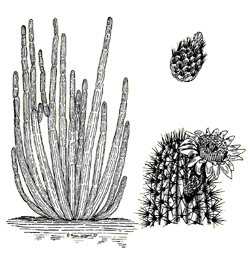
Organpipe cactus (Stenocereus thurberi)
Description
The many, usually unbranched stems that arise from ground level readily distinguish an organpipe cactus from a saguaro. The stems also are thinner, and have solid woody cores. Plants are usually 9 to 11 feet (2.7-3.4 m) in height, but occasionally exceed 20 feet (6.1 m). The pinkish-white flowers, produced from April through August, open after dark and close shortly after sunrise. The spines on the fruit loosen and fall at ripeness. The juicy, sweet, red pulp contains many tiny seeds.
Range
In Arizona the organpipe cactus is found mostly in Organ Pipe Cactus National Monument and the adjacent Tohono O'odham Indian Reservation in the south-central part of the state. In Mexico it occurs almost throughout Sonora, the southern half of Baja California, and barely extends into Chihuahua and Sinaloa. The desert is marginal habitat for this species; it is more abundant in thornscrub and tropical deciduous forest.
Notes
This tropical cactus is more frost sensitive than the saguaro, so it is restricted to the warmest microhabitats at its northern limit in the United States. It is most often found on south-facing rocky slopes below 3300 feet (1000 m) in elevation.
Nectar-feeding bats are the primary pollinators and some of the major seed dispersers. Because the flowers close at daybreak, diurnal animals are not significant pollinators as they are of saguaros. The fruits of organpipe cactus are widely regarded as the second-best-tasting fruit of all cacti (after those of Stenocereus gummosus). Commercial harvest is feasible in some large populations, and fruits are sold in markets in Sonora and Baja California.
Organpipe is the dominant plant in a strip of thornscrub several miles wide along the coast of southern Sonora; they grow so densely that visibility is seldom more than a few yards (meters), and with the other thorny vegetation they form nearly impenetrable thickets.
The ribs are used in housing. The Seri made boat sealant from dried organpipe flesh and animal fat. Slabs of heated organpipe flesh were used as compresses for aches.
Lophocereus schottii [Pachycereus schottii]
English names: senita (borrowed Spanish name; see Notes below)
Spanish names: sina, sinita, garambullo, cabeza de viejo (old man’s head), tuna (or pitahaya) barbona, hombre viejo (old man), musaro, senita (see note)
Description
Senita generally grows 10 to 13 feet (3 to 4 m) tall and has the same general form as organpipe cactus. It differs in having stems with only 5 to 7 (rarely up to10) ribs and very short spines on the juvenile stems, giving them a sharply angular aspect. Mature (flower-producing) stems are quite different; they’re densely covered with long, bristly, gray spines. Pink, nocturnal flowers about an inch (2.5 cm) in diameter emerge through the bristles from April through August; they emit an unpleasant odor. They are followed by marble-sized red fruits with juicy red pulp.
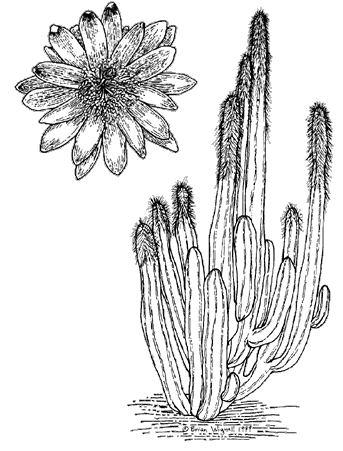
Senita (Lophocereus schotti)
Range
Senita is found in desert and thornscrub in Sonora and Baja California. Several small populations occur in Arizona in Organ Pipe Cactus National Monument and on the Tohono O'odham Reservation. There is also a historically transplanted population on the Gila River Indian Reservation in Sacaton, Arizona (south of Phoenix). The plant grows in very arid habitats, usually on fine-textured valley soils. It often grows in close association with desert ironwood trees. Senita is more frost tolerant than organpipe cactus, but because it grows on the colder valley bottoms its range doesn’t extend as far north.
Notes
Senita has a recently discovered mutualistic relationship with a moth that deliberately pollinates the flowers and uses the developing fruit as food for its larvae. The relationship is very similar to that of the yucca and its pollinating moth, and only the third such example of a tight pollination-related mutualism known in the world. Senitas are very long-lived. When sites in Baja California photographed in 1905 were revisited in the 1990s, nearly every senita was still present.
The word “senita” seems to be derived from the Spanish root meaning “old,” in which case it roughly translates as “little old woman.” This is rather descriptive of the gray-bristled mature stems. But “senita” is not a legitimate Spanish word. The Mexican name of the cactus is borrowed from the original Indian name, sina. Some feel that the Spanish vernacular name should therefore be spelled “sinita.”
Pachycereus pringlei
English name: elephant cactus
Spanish names: cardón, sagüera, sagueso, sahuaso
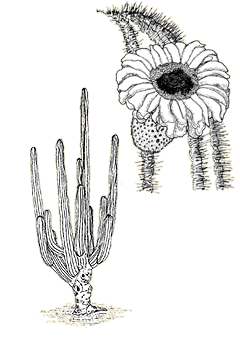
cardón Pachycercus pringlei
Description
The cardón resembles the saguaro in growth form but it is much more massive. It develops a very thick trunk and the branches are closer to the ground and often more numerous than those of a typical saguaro. In sheltered locations plants may exceed 60 feet (18 m) tall. Young stems are armed with stout spines; mature stems are nearly spineless and have bluish epidermis between the rows of closely-spaced felty areoles on the external ribs. The flowers are similar to those of a saguaro, but with more and narrower tepals. The ovoid fruits are densely covered with felty areoles; on different plants they range from spineless to very long-spiny. The juicy pulp of ripe fruits ranges from white to red and contains large, hard seeds — very different from the tiny seeds of the saguaro.
Range
The cardón occurs in most of Baja California, on the coast of Sonora, and on the islands in the Gulf of California. Its northern limit is determined by frost, to which it is very intolerant. The northernmost plants in Sonora are near Caborca.
Notes
Though the flowers may open before dark and remain open past dawn, nectar-feeding bats perform most of the pollination of this species. Cardón was recently found to have a trioecious breeding system; that is, plants have 1 of 3 variations of gender. Some have only male flowers that produce pollen but no seeds, some have only female flowers, and some have perfect flowers (each flower produces pollen and has fertile ovaries). There are also a few plants that have neuter flowers, producing neither pollen nor seeds.
The Seri eat the pulp and seeds of cardón, which is more abundant in their land than saguaro. Historically, house walls and walking sticks were made out of the ribs.
Genus Peniocereus
Peniocereus greggii
English names: desert night-blooming cereus, Arizona queen-of-the-night
Spanish names: saramatraca, reina-de-la-noche
Description
The stems of this cactus are usually few in number, thin and barely succulent, to about 3 feet (1 m) tall. The plant grows from a large, starchy underground tuber that can occasionally weigh more than 40 pounds (18 kg). The nocturnal white flowers are about 3 inches (8 cm) across with very long floral tubes, and are strongly scented. (Some people can’t smell them.) They close soon after the morning sun reaches them.
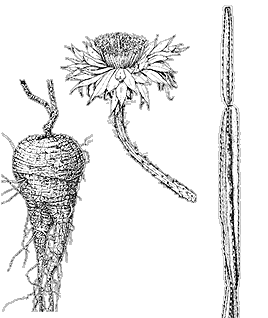
Desert night-blooming cereus
(Peniocereus greggii)
Range
This cactus can be found in Southern Arizona to southern Texas and adjacent northern Mexico, as well as in Baja California.
Notes
The plants grow under desert ironwood, creosote bush, and other desert shrubs; the stems are extremely difficult to distinguish from those of the shrubs that provide shade, physical support, and concealment. When the stems are eaten by herbivores such as white-throated woodrats (packrats) and cactus borers (Cactobrosis fernaldialis), new stems soon sprout from the tuberous root.
This is one of the Sonoran Desert’s most famous yet least encountered plants. It is virtually invisible most of the year, but on a few nights it becomes stunningly conspicuous. Some experienced field botanists spent months scouring a small tract of land to locate and tag all of the plants for an ecological study. Then on a night when the plants flowered they found enough new plants to double their known population size.
Plants in each population bloom in synchrony; large ones can produce a score of flowers at once. The legend is that they all bloom on a single night per year. Reality is almost as intriguing: each plant produces only 3 to 5 flushes of flowers between late May and early July. During each flush most of the flowers open on one night, with a few stragglers the night before or after the big bang.
In ideal cultivated situations where the plants are protected from predators, these cacti can grow hundreds of times larger than they do in nature. Archaeologist Julian Hayden had a plant in his Tucson yard that was over 8 feet (2.4 m) tall and perhaps twice as wide. Its great tangle of stems produced 200 flowers on one night and another 100 on the following night.
Desert night-blooming cereus plants usually occur as widely-separated individuals, and the flowers are not self-fertile. The flowers are cross-pollinated by hawk moths (Sphingidae) which fly hundreds of yards between plants in their search for the nectar reward. The cactus fruit turns red when ripe, attracting birds that eat the pulp and disperse the seeds in their droppings. The root is used medicinally to treat diabetes and other maladies.
This cactus is a desert version of the canary in the coal mine, an early warning that something is wrong in the ecosystem. Where pesticides are heavily used in agricultural areas adjacent to natural habitat, the hawkmoth populations are devastated and most of the flowers fail to fruit. This is an example of chemical habitat fragmentation; the habitat appears to be intact, but some of its ecological processes have been destroyed or degraded.
Genus Stenocereus
Stenocereus eruca
English name: creeping devil
Spanish name: chirinola, casa de ratas (rat house)
Description
This bizarre cactus migrates across the desert during its lifetime. The living sections of the very spiny stems are usually 5 to 10 feet (1.5-3 m) long; they lie prostrate with only the terminal few inches raised above the surface. Stems root near the growing tips and older stem portions die and disintegrate, so the plants literally creep across the landscape over time. In some areas they occur as widely scattered individual stems; in favorable localities they form impenetrable patches of branching stems several yards (meters) across. Large, nocturnal white flowers are produced sparingly, probably in response to rain.
Range
The creeping devil is found only on sandy soils on the central Pacific coast of Baja California Sur.
Notes
In addition to its unusual growth habit, creeping devil is elusive. To find some populations one must venture onto 4-wheel-drive trails that shift locations with the dunes; the maps always seem to be wrong. On a recent expedition we headed westward from a tiny community that our map indicated was 5 miles from the coast. An hour later our odometer and compass said we should have driven into the Pacific 5 miles before, but the ocean was beyond several more ridges of dunes. But we did find the creeping devils. Hundreds of them were scattered in the clearings, aimed in all directions. They looked so alien that we joked about whether it would be safe to camp among them. In Baja California where there are so many strange-looking plants, such thoughts are mundane.
Creeping devil grows rapidly in cool maritime climates like its home. In the mild climate at the Huntington Botanic Gardens, stems grow in excess of 2 feet (50 cm) a year; at the hot, arid Desert Museum, the plant grows only about 2 feet a decade.
Stenocereus gummosus
English name: none
Spanish name: pitahaya agria (sour pitahaya)
Description
This is a sprawling, shrubby plant with many sparsely-branched stems from the ground to about 10 feet (3 m) or more tall. Taller stems bend from their weight and lean on one another; those that touch the ground take root and branch, eventually forming large thickets. Big white nocturnal flowers are followed by fruits the size of small oranges with bright red skin and pulp. Flowering is mainly in summer, but also at other times in response to rain.
Range
This cactus is widespread in most of Baja California except in the high mountains and the arid northeast coast. Disjunct populations occur on the midriff islands and coastal Sonora opposite Tiburón Island.
Notes
The fruit is widely regarded as the tastiest in the whole cactus family; it is sweet yet slightly tart, with a crisp texture. The fruits are produced over a long season, but in such small numbers that commercial harvest is not viable. Plants are long-lived and extremely slow-growing. Most specimens identified in 1905 photos were still present when resurveyed in 1996; many had not increased appreciably in size. Because of these traits pitahaya agria will always be a rare, mouth-watering treat to be sought on treks to Baja California.
Genus Echinocereus
English name: hedgehog cactus, strawberry cactus (many species)
Spanish names: See individual species
Description
The Sonoran Desert species of this genus have upright stems, usually not more than a foot (30 cm) tall, and typically in clusters. A few of the 44 currently recognized species in the genus have single stems. The ribbed stems help distinguish hedgehogs from the mammillarias, with which they are sometimes confused. Spines are straight or slightly curved, never hooked as in many mammillarias. The flowers are funnel-shaped or partly funnel-shaped, but abruptly flaring outward about 2¼ inches (6 cm) across in most Sonoran Desert species. Some are long, narrow funnels conducive to hummingbird or moth pollination. Flowers come in many colors, including white, yellow, pink, purple, and red; some are bicolored. The stigmas are usually green. Some species of Echinocereus are readily distinguished from other cacti by the flower buds that rupture through the skin of the stem, rather than emerging from the areoles. Nearly all species flower in the spring, though a Baja California species flowers in August or September. One species within the Sonoran Desert and a few beyond it have thin, trailing stems.
Range
Species occur in nearly all habitats in the arid southwestern United States and southward well into Mexico.
Notes
The fruits of several species are large, juicy, and tasty. They were eaten by indigenous peoples when they could get them before the birds and squirrels did. The genus is popular among cactus collectors because most species are of moderate size and have beautiful flowers.
Echinocereus brandegeei
English names: none known
Spanish names: pitayita (little pitaya), casa de rata (rat house)
Description
This is a variable cactus. The stems grow in clusters, which vary from a few stems to great mounds more than 6 feet (2 m) across. Individual stems on different plants may be short and erect or long and trailing. The spines are also extremely variable in size and color, with color ranging from brownish to clear white or bright yellow. The flower tubes flare abruptly outward to about 3 inches (8 cm) across and are purplish lavender to pale pink. This species is unusual in the genus — it flowers in late summer instead of spring.
Range
This cactus is widespread in the southern half of Baja California, where it typically grows on rocky hillsides.
Notes
In some parts of its range E. brandegeei grows among devil’s club cholla (Opuntia invicta). In these locations plants of the former species tend to have short, stout stems and very broad spines; they look remarkably like the cholla. The adaptive value of this convergence, if any, is unknown.
Echinocereus engelmannii
English names: strawberry hedgehog, calico cactus
Spanish names: sinita barbona (bearded little sina), cacto fresa (strawberry cactus), pitayita
Description
This hedgehog grows in clusters of up to 60 cylindrical stems, each up to 1 foot (30 cm) tall (rarely 3 times as tall). Sprouting from the closely-spaced areoles are 2 to 6 (usually 4) long central spines and 6 to 14 radial spines. Brilliant, deep purplish-red to lavender flowers open in April. The fruit has a juicy, tasty, red pulp.
Range
This plant grows throughout much of the Sonoran and Mohave deserts and southern Great Basin Desert, mostly in rocky or gravelly soils.
Notes
This species has several varieties, most of which are difficult to distinguish from E. fasciculatus. The latter species typically has 1 long central spine and 1 to 3 shorter central spines. There are two Chihuahuan Desert species with the same vernacular name, E. enneacanthus and E. dasyacanthus. (See also the next species.)
Echinocereus fasciculatus
English names: strawberry hedgehog, robust hedgehog
Spanish name: pitahayita
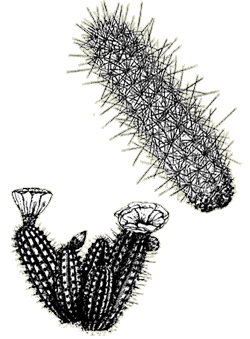
Strawberry hedgehog (Echinocereus fasciculatus)
Description
This plant looks very similar to E. engelmannii described above (they may be a single species). On close inspection one can see that the areoles each have only 1 principal central spine and about 12 radial spines. The brilliant magenta to reddish-purple flowers bloom in the spring, usually in the first half of April in Tucson. The fruit — pale red outside when ripe — has bright red, fleshy pulp.
Range
This species is found in desert habitats from central Arizona to northern Sonora.
Notes
Some taxonomists favor elevating the varieties of this species — E. fasciculatus var. fasciculatus, E. fasciculatus var. boyce-thompsonii and E. fasciculatus var. bonkerae — to full specific rank. Echinocereus fasciculatus var. boyce-thompsonii (Boyce Thompson hedgehog) differs from the typical variety in having much longer, downward-pointing spines. The flowers are usually very deep purple. Echinocereus fasciculatus var. bonkerae (Bonker hedgehog) has fewer (5 to 15) stems and very short white or pale gray spines. Its flowers are also deep purple. Most of the plants in this group have 4 sets of chromosomes, but at least one of the varieties includes individuals with 2 sets.
Echinocereus nicholii
English name: Golden hedgehog
Spanish name: none known
Description
This is a large hedgehog with clusters of as many as 30 stems up to 2 feet (60 cm) tall, thickly clothed with long yellow spines. The light- to medium-pink flowers bloom in April. It was formerly classified as a variety of E. engelmanii.
Range
The golden hedgehog grows in south-central Arizona, mostly from Tucson to Organ Pipe Cactus National Monument, and also in adjacent Sonora.
Notes
When backlit by the sun, the spines of this cactus create a dazzling golden-yellow halo.
Genera Ferocactus and Echinocactus
English name: Most species are called barrel cactus
Spanish name: biznaga (a general name for barrel-shaped cacti)
Description
The following is a general description for both genera of barrel cacti: The stems are globular to columnar, usually unbranched, and pleated, ranging from less than a foot (30 cm) tall in the smallest species to 6 to 12 feet (1.8-3.7 m). The central spines are the larger of two types and arise from the center of the areole; the principle central spine often has a different shape from that of all the other spines. Radial spines are smaller and arise from the margins of the areoles. The short, funnel-shaped flowers are very stiff and usually don’t extend beyond the spiny armor. The thick rind of the fruit is moist in Ferocactus, dry at maturity in most Echinocactus. The seeds are packed in a dry interior, not embedded in pulp. Echinocactus differs from Ferocactus in having sharp-pointed scales on the flower tubes and woolly ovaries.
Range
There are 25 species of Ferocactus and 6 of Echinocactus in the world. In the Sonoran Desert there are 9 and 2 species, respectively.
Notes
The majority of Ferocactus species flower in summer and are pollinated by bees in the genus Lithurge. The fruit and seeds are eaten by rodents, birds, mule deer, bighorn sheep, and javelina. The plant itself is eaten by cactus beetles (Moneilema gigas and other species), jackrabbits, packrats, and javelina.
The surface area of barrels and other more or less globose plants is small compared to the volume, so evaporative losses are small relative to the large volume of water stored. Repeat photography of sites in Baja California in 1905 and the 1990s indicate that the life spans of barrel cacti are typically less than a century.
One of the great fables of desert survival is that barrels and other cacti are reservoirs of water that can be easily tapped and drunk. It is true that indigenous peoples and a few other desert residents know how to obtain emergency water from cacti. But most city dwellers, including most aspiring survivalists, could not get water from any cactus if their lives depended on it (pun intended).
The first problem is getting to the pulp inside the very tough and spiny epidermis. A pocket knife is inadequate, and tools that are typically carried in a car, such as tire irons, aren’t very effective either. The labor of cutting into a barrel on a hot day is likely to cause loss of more water from sweating (and perhaps bleeding) than one would gain from the cactus.
Secondly, the water in cactus pulp is tightly bound in a gooey mucilage. ost of the year the pulp is more like a damp sponge than a watermelon — you can’t squeeze much liquid out of it. Furthermore, the raw pulp of many cacti is inedible. Some species have potentially toxic levels of oxalic acid (prickly pears), bitter and sometimes toxic alkaloids (senita and many other cacti), or other substances that cause diarrhea (some barrels) or vomiting. The best cactus for emergency water is Ferocactus wislizeni. See more details under that species. For a historical account of extracting water from a barrel cactus (in cool weather and when it was legal), see Camp-Fires on Desert and Lava by William T. Hornaday, pages 216-219.
Water can be obtained from cacti using a machete and solar still. But anyone with the foresight to pack these tools is smart enough to carry plenty of water and inform friends of the itinerary and expected return date!
Caution: native wild cacti are protected by state laws; it is illegal to take or destroy them. In addition, most barrels cannot branch, so cutting out the top is lethal.
Echinocactus polycephalus
English names: many-headed barrel, cottontop cactus
Spanish name: biznaga de chilitos (little chile barrel)
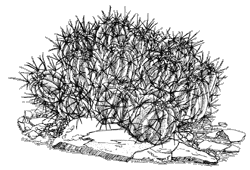
Many-headed barrel
(Echinocactus polycephalus)
Description
This Echinocactus is unique as the only barrel in our region that branches under normal conditions. The 8-inch (20 cm) diameter heads occur in clusters of up to 200, forming mounds to 3 feet (1 m) across and somewhat less high. The dense, stout spines obscure the plant bodies and restrict the small yellow flowers from opening fully; they appear in July. The brown spines appear bright red when wet from rain.
Range
This cactus occurs mostly on rocky and gravelly slopes in the driest parts of the Sonoran and Mohave deserts. It is rarely found where rainfall exceeds 5 inches (130 mm). (E. polycephalus var. xeranthemoides, occurs in the northern Mohave and Great Basin deserts, where there is more rain.)
Notes
Many-headed barrel cacti are slow-growing and probably very long-lived. Plants grown from seed at the Desert Museum are just beginning to branch at nearly 20 years of age. This species is also geographically stable; its range has not changed for at least the past 30,000 years despite the dramatic climatic swing from ice age to a warm interglacial period. Though the fruits seem to be imprisoned within the spiny armor, birds and packrats can get to them and disperse the seeds.
Turk’s head or eagle’s claw cactus (E. horizonthalonius var. nicholii) is in the same genus but has a different growth habit; it nearly always has a single stem. One variety of Turk’s head is common and widespread in the Chihuahuan Desert. Our variety is endangered and restricted to 3 small populations in Arizona and Sonora on limestone. The flowers are pollinated by bees. The fruits remain buried among the spines; they eventually disintegrate and the seeds simply fall to the base of the mother plant. Bighorn sheep and javelina eat the whole plants and probably function as occasional long-distance seed dispersers. Javelina only recently migrated into the Sonoran Desert, and their added predation may be exterminating this cactus.
Ferocactus cylindraceus [F. acanthodes]
English names: spiny barrel, California fire barrel, compass barrel
Spanish name: biznaga
Description
This barrel cactus is narrow-columnar rather than barrel-shaped. It grows up to 10 feet (3 m) tall, but is usually less than half that. Stems are nearly always single; like most other barrels this cactus branches only when the tip is damaged. The spines are usually reddish (bright red when wet), but yellow or brownish in some forms. The central spines are flat and curved at the tips, but not hooked. The many bristly radial spines obscure the body of the plant. Crowns of flowers are crowded among the dense spines at the stem tips and are almost always yellow, though some plants in the Pinacate region have orange to red flowers. Flowering is usually in March and April; some populations near Phoenix flower in summer.
Range
The spiny barrel occurs in northern Baja California and Sonora, southern California, and Arizona. It usually grows on steep rocky slopes, rarely occurring side-by-side with the fishhook barrel, which generally is found on gravelly bajada soils.
Notes
Because of this barrel’s cylindrical shape, it could be confused with a young saguaro if one fails to notice the hooked spines. The Seri name for this species means “thinks it’s a saguaro.” In Baja California F. cylindraceus can be confused with F. gracilis; the latter species has red flowers while those of the former are almost always yellow.
Ferocactus emoryi [F. covillei]
English name: Coville barrel, Emory’s barrel
Spanish name: biznaga
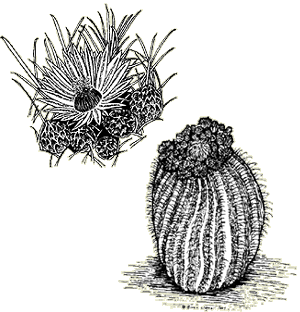
Coville barrel (Ferocactus emoryi)
Description
The description that follows applies to the desert populations of this barrel. Coville barrel is easily recognized by the relatively few spines per areole, all of which are stout (not bristly). The main central spine in each areole, usually red, is strongly flattened and hooked. Young plants are first globular, then barrel-shaped, but more slender than fishhook barrels. They are typically 1 to 4 feet (30-120 cm) tall. The bright red flowers open in July to mid-August before F. wislizeni blooms. Juvenile plants are very distinctive in bearing their spines at the ends of large tubercles rather than along ribs; they look like giant mammillarias.
Range
This desert form occurs from south-central Arizona to central Sonora.
Notes
The Seri name for this species translates “barrel that kills.” Eating its flesh or juice causes nausea, diarrhea, and temporary paralysis. The Seri use the pulp as a pain-relieving poultice, further evidence that there are some active chemicals in this plant. However, the flowers and fruit are edible (no cactus fruit is poisonous, though some are inedible).
The desert populations were originally described as F. covillei. The populations in the thornscrub of southern Sonora (the original F. emoryi) are massive barrel-shaped plants up to 9 feet (2.7 m) tall and almost 3 feet (0.9 m) in diameter, with shorter curved but not hooked yellow spines and yellow flowers. Between Hermosillo and Guaymas, Sonora, the 2 forms intergrade, which is why they were combined into a single species. It’s exciting to see the variability in such intergrading populations. We found one plant that had both red and yellow flowers; they opened yellow and changed color with age.
Ferocactus emoryi var. rectispinus
English name: straight-spined barrel
Spanish name: biznaga
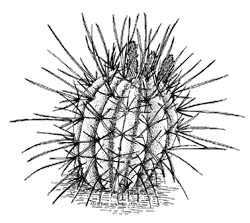
Description
Plants are barrel-shaped when young and rarely exceed 3 feet (1 m) tall. They become more cylindrical in age and occasionally reach 9 feet (2.7 m). This barrel cactus is easily recognized by its 6- to 11-inch (15-28 cm) long, straight central spines. When backlit by the sun on a rocky slope, it is surrounded by a glowing reddish aura that is much larger than the plant’s body. It has a few stout radials, but lacks bristly spines. The yellow flowers bloom in August and September.
Range
This is a rare cactus that occurs in its pure form only near the gulf coast of central Baja California. A few miles inland it hybridizes freely with F. peninsulae, forming hybrid swarms with variable spine lengths and curvature, and red-tinted flowers.
Notes
Straight-spined barrel is one of the many outstanding botanical marvels of Baja California. Many cactophiles have ventured off the main highway to seek it and pay homage to it. Because populations are very sparse and the terrain extremely rugged, it is a difficult quest, and finding even a single specimen is a thrill.
Ferocactus wislizeni
English names: fishhook barrel, Arizona barrel, compass barrel
Spanish name: biznaga de agua (water barrel)
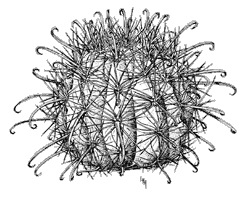
Fishhook barrel (Ferocactus wislizeni)
Description
The thick, barrel-shaped body of this cactus is usually 2 to 4 feet (0.6-1.2 m) tall, occasionally reaching over 10 feet (3 m). The ribs bear broad, flat, strongly-hooked central spines as well as several bristly radial spines, but not enough of these to obscure the stem. The flowers are not strongly crowded by the spines and open wide. Flower color is extremely variable; on most plants they are some shade of orange, often with a stripe of darker shade on each petal. About 10percent of the plants have yellow or red flowers. They are produced over a 2-month-long season, August and September, much longer than the blooming period of other barrels.
Range
Populations of this barrel are concentrated in south-central Arizona and adjacent northern Sonora. There are also some populations in southern New Mexico and western Texas. The distinct variety on Tiburón Island may well be a distinct species. The fishhook barrel is most abundant on gravelly bajadas; it is less common on rocky slopes or silty valley floors.
Notes
This is the barrel that the Seri and others prefer to use for emergency water; Seris have survived on it for as long as a month. The juice is flat-tasting but not completely harmless. Drinking it on an empty stomach often causes diarrhea, and some Seri experience pain in their bones if they walk a long distance after drinking the juice. The seeds are not enclosed in a juicy pulp, but are edible, as is the sour rind. The O'odham eat the persistent fruit much of the year as an emergency food. The Seri also eat the flowers and buds.
Cactus bees (Lithurge spp.) pollinate the flowers. The fruit persists until it is removed by animals and may remain on the plant for more than a year. Birds, squirrels, and large mammals such as deer and javelina are the main consumers of the fruit. Plants grow fairly slowly, and large specimens are more than a century old. In cultivation, with supplemental water and fertilizer, they reach flowering size of 10 inches (25 cm) diameter and the same in height in about 12 years.
Ferocactus wislizeni and F. cylindraceus have the vernacular name “compass barrel” because large plants of these species tend to lean toward the southwest. It has been hypothesized that the intense heat from the afternoon sun retards growth on the southwest side of the plants, and the greater growth on the cooler side pushes the plants over. Large leaning plants may topple when the soil is softened by heavy rains. Ferocactus herrerae (twisted barrel) is included in F. wislizeni by some botanists. As the common name suggests, its ribs are often spiraled. It is found in southern Sonora and into Sinaloa. Its flower color (always yellow with brown tips) and its distribution (there is a 100 kilometer gap in Sonora where neither barrel occurs) give rise to some doubt that it belongs to the same species as fishhook barrel.
Genus Mammillaria
English names: pincushion cactus, mammillaria, nipple cactus
Small, attractive, diverse, and generally easy to cultivate, mammillarias enjoy enormous popularity with collectors. Perhaps because of this, many minor geographical variants have been described as species — resulting in more than 400 named species. Thorough field work and genetic analysis often reveal that populations described as separate species actually belong to a single, variable species.
Description of Genus
Even after duplicate names are sorted out, Mammillaria is the largest of several genera of diminutive cacti with about 175 species worldwide. The Sonoran Desert species are less than 6 inches (15 cm) tall, with closely-spaced areoles bearing many spines that obscure the body of the plant. The areoles are at the tips of long tubercles that are arranged in 2 spirals (one clockwise, the other counterclockwise). These tuberculate stems contrast with the ribbed stems of the genus Echinocereus. In addition, many mammillarias have hooked central spines, whereas no hedgehog does. Plants range from single stems to large clusters, depending on species. Flowers, usually less than an inch (25 mm) in diameter and either pink or white, are produced in a ring near the tip of the stem.
Range
Various species grow from the lowest desert habitats to cold conifer forests and fairly wet tropical forests. The genus ranges from southern California to central Texas and southward through Central America. About 25 described species occur in the Sonoran Desert; some of these may be combined in the future.
Notes
The fruits of mammillarias are edible, though their small size makes them difficult to gather in nutritionally significant quantities. Some are pleasantly tart, others bland. The O'odham call them “coyote’s paws” to contrast them with the larger, juicy fruits of hedgehogs. (See Cucurbita digitata, coyote melon, for an explanation of “coyote” plants.)
Mammillarias often go through “boom-and-bust” population cycles. Mammillaria thornberi, for example, is so rare that it was considered for listing under the Endangered Species Act in the 1980s. But in the 1930s it occurred in countless millions in the Avra Valley west of Tucson. This vast population all but disappeared after the catastrophic freeze of 1937. The population has never recovered; no one knows why.
Mammillarias can be confused with plants of several other genera of small cacti such as Coryphantha, Epithelantha, and Neolloydia. Consult a field guide or taxonomic monograph to sort them out.
Mammillaria grahamii [M. microcarpa]
English names: fishhook pincushion, Arizona fishhook
Spanish name: cabeza de viejo (old man’s head)
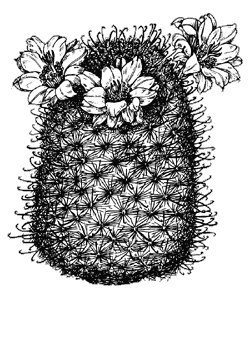
Fishhook pincushion
(Mammillaria grahamii)
Description
Single or clustered cylindrical stems grow to about 6 inches (15 cm) tall. The plant body is nearly concealed by dense, white, straight radial spines, in contrast to 1 to 3 central spines per areole, one of which is dark-colored and hooked. Crowns of bright pink flowers almost an inch (25 mm) across are borne just below the stem tips in early summer. The bright red, slightly fleshy fruits are presumably eaten by birds.
Range
Fishhook pincushion occurs in Arizona south of the Mogollon Rim south into Sonora in desert and woodland habitats.
Notes
This is the most common mammillaria in Arizona Upland. It is especially abundant among debris under jumping cholla and partially concealed beneath desert shrubs such as bursage (Ambrosia deltoidea). Like many small desert plants, it cannot tolerate full sun.
The flowers can be used as a monsoon season rain gauge. The buds are produced during the preceding summer growing season and usually remain dormant through the winter, spring, and foresummer. The buds burst into bloom 5 days after the first rain of the summer and last about a week. Plants produce a second and sometimes a third flush of flowers after subsequent rains.










